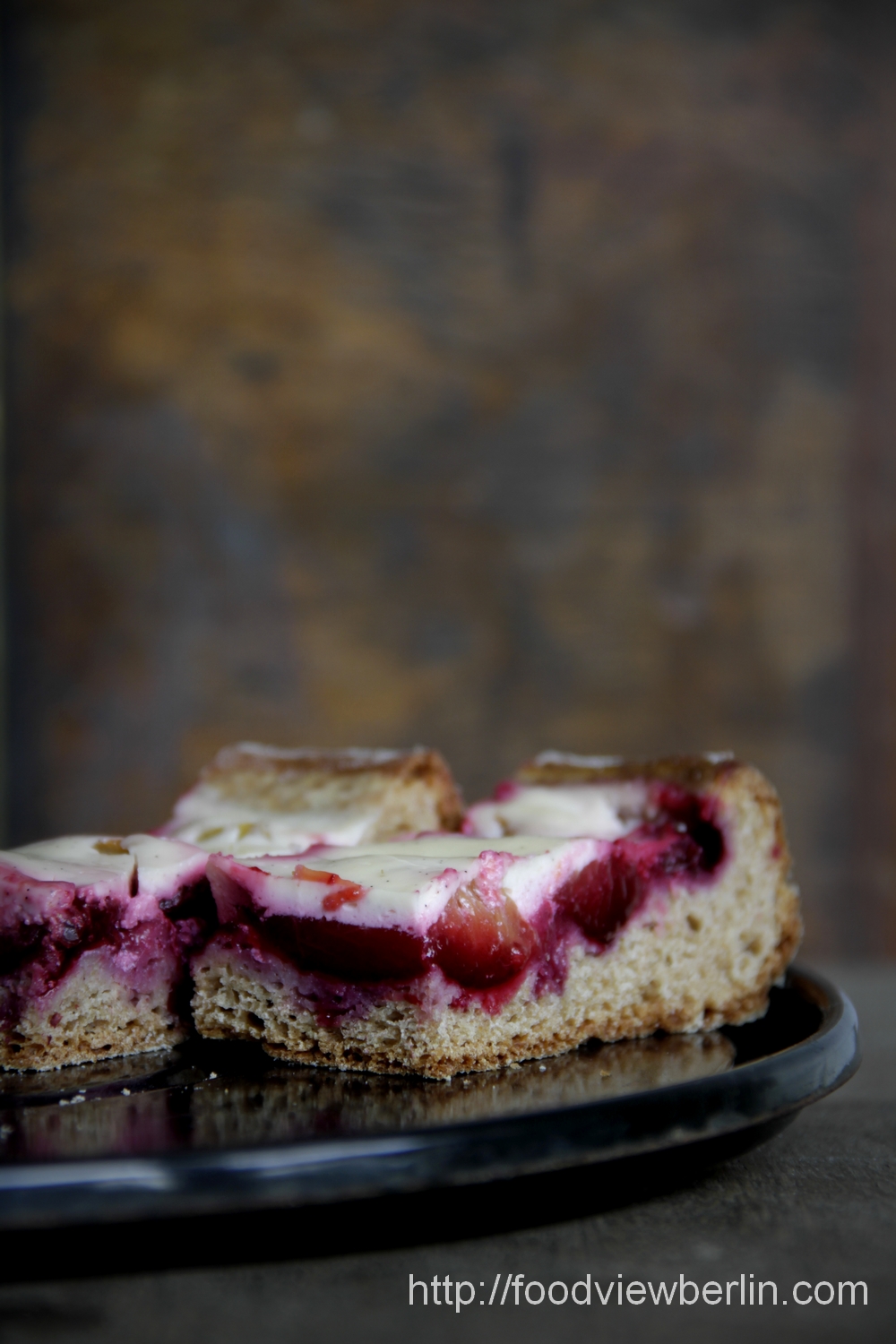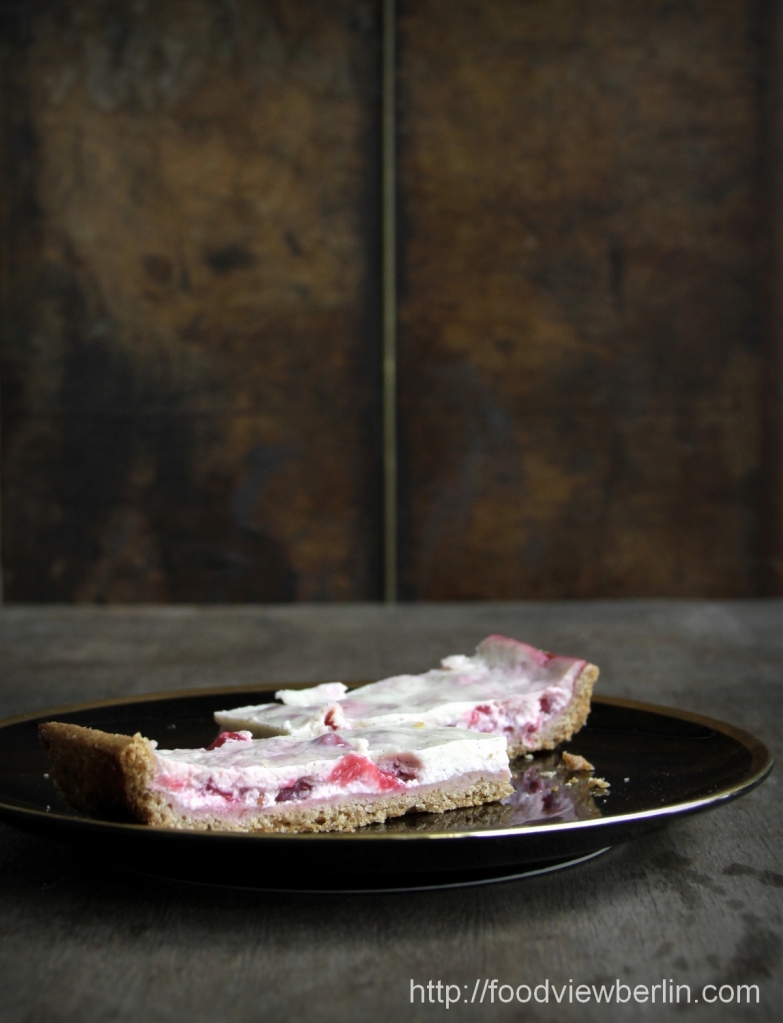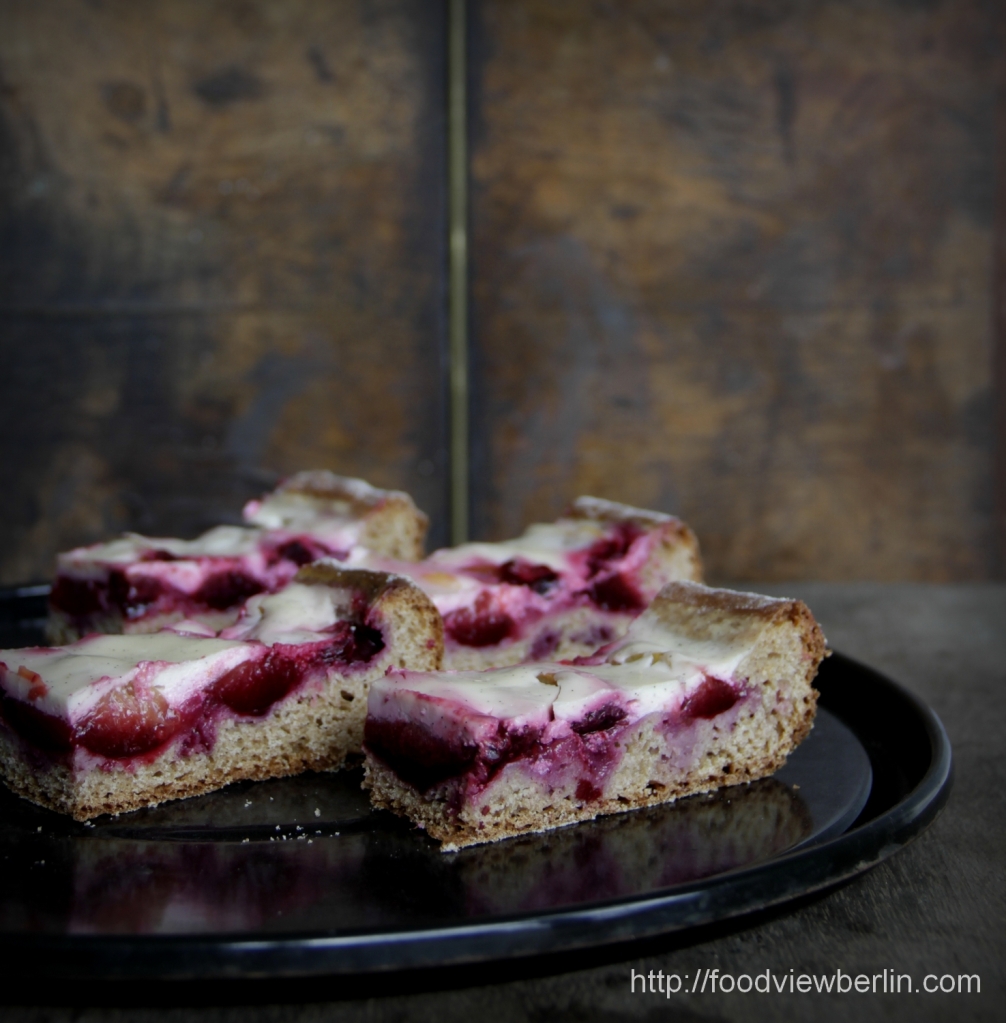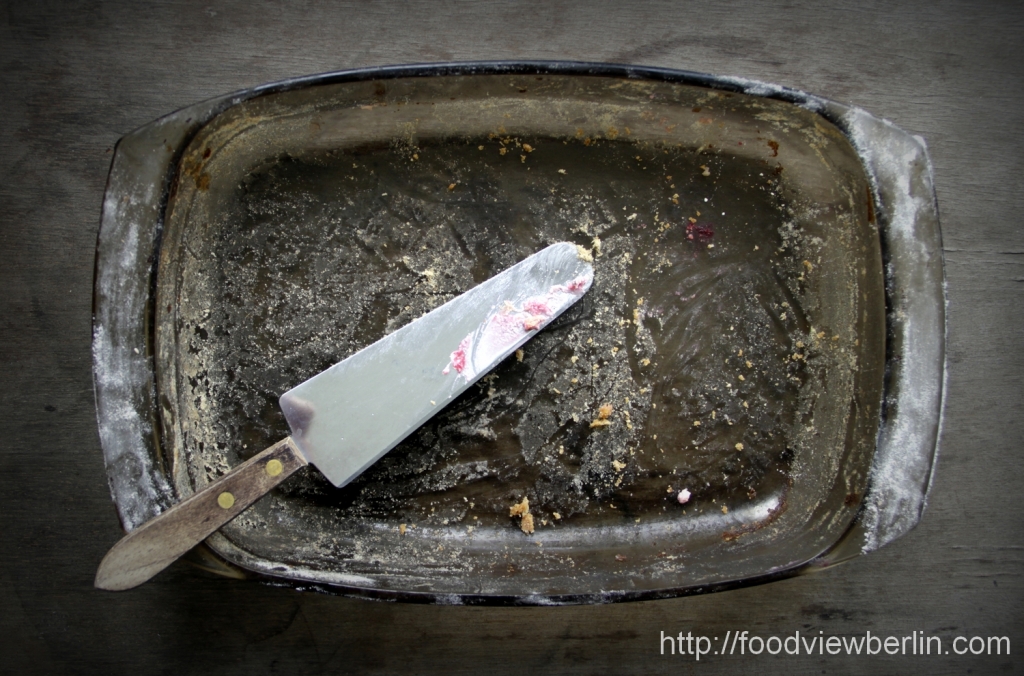There have been some pics about small discoveries in the city on this blog already – here’s another one. The other day, we passed a street corner near beautiful Kino International when we suddenly recognized something small situated in a place where – normally – you don’t suppose anything to be situated at all: on a street sign.
A friendly little street art fellow made of cork – who had disappeared after a few days already.
Today’s recipe is about a peace of art of its own – the unrivaled smetana cake (which is called Schmantekuche in Hessian tongue) of my grandmother. I had introduced my other grandma’s raisin cake already, and now it’s the Hessian granny’s turn. I have no clue how she did that simple, yet gorgeous cake that is a popular weekend pie in the Hessian countryside and small towns especially when cherries and plums are in season. But I do know that I suddenly had the idea to surprise my family with that treat on the occasion of our next get-together. I remembered a not too sweet yeast cake crust made on a baking tray and not in a springform, packed with fruits from her own garden, covered with a compact layer of smetana with the fruits shining through, and served in small stripes.
My first attempt was nice – but not at all like my granny’s cake. Indeed, it looked and tasted like vanilla pudding with cherries in a crust… I was a little disappointed and dusted all with lots of icing sugar because everything looks just better with it, doesn’t it:
By the way: Don’t be irritated because of the almonds in one of the pics – this has just been an idea for some extra topping which I abandoned in the end. Be that as it may: I called my parents who had good advice: no eggs with the smetana to avoid the pudding. On top, not below. And in the end, not right from the beginning. Message understood – I felt like I was already there. But in part, I was on the wrong path again…
On my second try with red currants, I confidently pre-baked the dough and added the smetana late – too late obviously, as the dough turned double-crispy (which is another word for nearly burnt) and the smetana stayed soft as – vanilla pudding. Oh my goodness. At least it didn’t taste like pudding, and with a few technical changes, this would be a nice summer cake:
But I didn’t want any nice summer cake, I wanted my granny’s cake. Next try: I prepared a free-style fluffy dough which had been allowed to rest as long as it wanted (and it wanted quite some time), added the smetana at proper time and took any fruits I had at hand:
Finally I got close (despite the mixed fruits) – but you know how it is: grandmother’s cakes are as unrivaled as childhood rememberances of best-loved foods. The Hessian smetana cake series will surely be continued once Zwetschgen will be in season ;-).
Here are my recipes
Usually, this cake is done on a baking plate of normal size. Since I assumed already in the beginning that I would need more than one attempt and didn’t want to overcrowd the freezer, I prepared smaller portions in a casserole of 20 x 28 cm. If you use a normally sized baking plate, you should be fine if you take 2,5 times as much of the ingredients as indicated in the recipes.
Smetana cake with a thin crust and red currants
The crispy French yeast dough had been fine with the red currants, and with the thin layer of currants on the flat crust, the proportions are perfect. The recipe for the dough is based on a recipe from Le Cordon bleu – Regional French, edited by Kay Halsey.
You will need:
200 g whole spelt flour, sifted
75 g cool butter
40 ml warm milk
6 g dry yeast
½ tsp. sunflower oil
1 egg
1 pinch salt
1 pinch raw sugar
250 g red currants, cleaned and stripped off the twigs
150 g smetana (Schmand – if you can’t get, you can mix sour cream and double cream half-half)
4 tbsp. raw sugar
pulp of 1 vanilla bean
Mix flour, yeast, sugar and salt, add the butter and mix with your fingertips. Add the egg, the milk and the oil. Mix well and knead for a couple of minutes. Put in a floured bowl, cover with a clean kitchen towel and let rest in a warm place (easy thing in summer, isn’t it) for at least 1 hour (or until the dough has doubled approximately).
Grease and flour a flat casserole (20 x 28 cm) or cover a baking plate with baking paper. Roll out the dough on a floured workspace and put into the casserole / on the baking plate and form a small rim. Cover the dough with the towel again and let rest for another 30 minutes.
Mix smetana, vanilla and sugar. Cover the dough with the currants (should be tightly packed but just one layer) and put to the preheated oven (200 °C). Bake for 10 minutes. Add the smetana mixture and bake for another 15-20 minutes. Take off the oven and let cool down. Cut into small stripes to serve.
Smetana cake with a fluffy yeast dough and cherries or plums
For this cake, I recommend cherries or plums as they have the right size not to get lost in the rising, fluffy dough.
You will need:
250 g whole spelt flour
1 pinch of salt
1 tbsp. raw sugar
100 ml warm milk
6 g dry yeast
35 g butter
1 egg
500 g cherries or plums (Zwetschgen will be best), cleaned and pitted
250 g smetana (for hints, check recipe above)
4 tbsp. raw sugar
pulp of 1 vanilla bean
Mix flour, yeast, sugar and salt, add the butter and mix with your fingertips. Add the egg and the milk. Mix well and knead for a couple of minutes. Put in a floured bowl, cover with a clean kitchen towel and let rest in a warm place for at least 1,5 hours (or until the dough has doubled approximately).
Grease and flour a flat casserole (20 x 28 cm) or cover a baking plate with baking paper. Roll out the dough on a floured workspace and put into the casserole / on the baking plate and form a small rim. Cover the dough with the towel again and let rest for another 30 minutes.
Mix smetana, vanilla and sugar. Cover the dough with the cherries or the plums (should be tightly packed but just one layer) and put to the preheated oven (200 °C). Bake for 15 minutes. Add the smetana mixture and bake for another 20 minutes. Take off the oven and let cool down. Cut into small stripes to serve.
Have a nice and fruity smetana cake summer weekend!
























Wundervolle Bilder, wie immer, Claudia! Ich bin mal wieder hin und weg. Und wie lustig, dass Du drei Anläufe unternehmen musstest, bis Du zufrieden warst, so was kenn ich gut, ich probiere seit Wochen an einem Brot herum, ich befürchte, das dauert noch eine Weile, bis das so ist, wie ich mir das vorstelle 🙂 Auf die Variante mit Zwetschgen würde ich mich auch noch freuen 😉
LikeLike
Lieben Dank, Julia! Die Zwetschgen kommen bald – und auf Dein Brot mit mehreren Anläufen wäre ich natürlich auch sehr gespannt (und bin beruhigt, dass ich mit dem Trend zum Multi-Anlauf in so guter Gesellschaft bin :-)).
LikeLike
Gorgeous post as always Claudia! Love the photography. I definitely understand your yearning to perfect a treat from your youth. I am the same with my mother’s apple cake; I’ve created a few versions but none have been quite the same. In terms of my grandmother’s cooking… haha. She was TERRIBLE! Everything she made turned into a burnt piece of rock-hard food. But I loved her just the same. Thanks for sharing these recipes, I’ll give them a try! xx
LikeLike
Thanks a lot, Laura! So we share the same experience – trying to find out the secrets of a very special cake :-). Great that you want to give my granny’s cake a try, I hope you will like it.
Your mentioning of your grandmother’s art of cooking made me smile – it’s humorous and very warm at the same time.
LikeLike
Yes, I have very fond memories of her and her terrible cooking. I loved her dearly. But no, there’ll be no ‘passing on’ of grandma’s recipes to my children when we have them! Haha! xx
LikeLike
Seams like you can be quite insistent. 🙂 How good that you needed only three attempts. The cake looks delicious and wouldn’t there be something matcha related on top of my list I would go right at it. 😉
LikeLike
Your are right, Eva, I have been quite picky this time – and there will be even further attempts ;-). I look forward a lot already to what you will do with matcha!
LikeLike
Die Fotos sind mal wieder traumhaft, da könnte richtig Neid aufkommen. Vor allem wenn ich daran denke, dass ich bald wieder ohne Tageslicht fotographieren muss 😉
LikeLike
Lieben Dank für das Kompliment! Die Möglichkeit, mit Tageslicht zu fotografieren, ist in der Tat ein Segen – ich versuche so zu arbeiten, wann immer es geht.
LikeLike
Seems like you are more patient than me 🙂
Thanks for the article…..now I can imagine why my hessian friend is crazy abaout Schmandkuchen 🙂
LikeLike
Usually, I am an impatient baker, but I can get quite eager if I want to impress my family ;-). And I can understand very well your Hessian friend’s passion for Schmandkuchen.
LikeLike
Beautiful post, comme toujours, Claudia. My Russian mom uses “crème fraîche” as a substitute for Smetana, do you agree that it is pretty much the same thing? I love its creaminess and acidity, and these two cakes are extremely appealing!
LikeLike
Thanks a lot, Darya! Créme fraîche is absolutely fine as well. It’s a bit more sour than smetana/Schmand and contains a bit more fat, and it’s surely just great with yeast dough and fruits, too.
LikeLike
We’re quite lucky that the cake wasn’t up to your standard on the first time. So we got more beautifull photos! I’m sure all the cakes are delicious. Your family will be quite happy!
Although I’ve been living in Hessia for nearly 15 years now, I never saw or tasted a Smetana cake like your granny’s. They probably don’t do that type of cake here in the Odenwald. I remember eating cake with a very thick spread of smentana in the north of Germany. The cake was very moist and filling.
Have a nice sunny weekend up in Berlin!
LikeLike
Thank you very much, Heike! I guess this version is special for the Northern Hessian region. I don’t know your version from Northern Germany (although I originate from there) but it sounds incredibly good. Have a nice summer weekend, too!
LikeLike
Never heard of “smetana” before – at least not in relation to heavy sour cream. Did you used original Russian smetana? Where did you find it?
Your cake recollects my grandma, too. But the cake which crosses my mind is a cake made of yeast dough, covered with heavy sour cream and sprinkled with sugar. The very special thing: After spreading out the dough onto the baking sheet one had to make many depressions by softly pressing the dough with fore- and longfinger. After that the heavy sour cream had been spread over the whole surface and at last the sprinkled sugar on top.
After baking, the depressions had had collected the sour cream and the sugar formed a fragile crust – sometimes like a bridge over the sour cream seas. And in this case I had my clandestine appearance: I carefully removed the sugar bridge, nibbled from the delicious sour cream and as carefully as before reconstructed the sugar bridge.
No one never detected my criminal act. At least nobody confronted me with it.
So, dear Claudia, I think it’s time to go back and try to reproduce my grandma’s treat. Thank you so much for the wonderful journey into the past 🙂 🙂
LikeLike
You’re most welcome, Antje, to join the little cake journey back in time – your remembrance, both of the cake and your little trick, are most beautiful :-).
Smetana is what Wikipedia indicates as the English term for Schmand, both in Eastern and Middle European as well as Hessian cuisine (I was quite surprised that the latter is explicitly mentioned in the article). So Schmand is what I took, like indicated in the first of the two recipes, but this term might be less widespread than smetana.
LikeLike
Ah, thanks for your explanation. My mostly used dictionary dict.cc says, the English term for “Schmand” is “heavy sour cream”. To learn more about “Smetana” I asked Mr. Google – his answer was a very helpful website about all sorts of Schmand, sour cream and others (in German language): http://www.schmand-sahne-rahm.de/ And there’s the difference: The Schmand’s fat content is 20-29%, the Smetana’s is 30-42%. Once again I see, the world of sour cream & friends is at least three worlds 😉
LikeLike
Thank you for sharing your research results with us! I looked up some more facts, too: While German smetana/Schmand is semisolid, Eastern European smetana is creamy, and the latter is made with soured heavy cream while the former is made with soured cream. I also found out, that in Eastern European countries smetana is sold in several varieties for different use from low fat to full fat (up to 70 %, must be a dream of a cream – I need to check with the tiny Russian store in a shopping centre nearby if they sell it :-)).
LikeLike
I’ve never had a cake like this! It’s almost like cake layered with fruit and cheesecake. Looks so yummy! I’m glad you were able to work out the recipe so that it’s close to what your grandmother made. 🙂
LikeLike
Thank you, Puja! Indeed, it’s not so far away from cheesecake with fruits (the smetana is just a bit more sour than cream cheese).
LikeLike
Practice makes perfect and we all benefit from your quest to achieve the taste of your childhood 😀 Thank you. Schmandkuchen is quite delisious, but I’m more a puddingcakegirl ;). The little corkman reminds me to take a picture of a little “Trinkpack-Man” sitting on the trafficlights down the road. I smile everytime i see it and then forget to take a picture. Hope its still there.
LikeLike
Pudding cake girl is such a beautiful expression :-). Hope to see the little trinkpack man soon on your blog!
LikeLike
I’m not starring at the cake… NO!
I don’t even look.
I’m lying.
And when I read the title I thought, hey, Smetana, the Composer, what does he have to do with a cake??
But besides the cake that I’m definitely not starring at, I love the background. Is this a wallpaper? So curious, so man questions.
LikeLike
many questions….
LikeLike
Dear Claudia who is not starring and not even looking at the cake ;-): When I looked up the English term for Schmand, I thought the same as you: why is a dairy product named after a componist? Or is it vice versa? I took a closer look now and I found out, that smetana originally means a person who trades dairy products. This won’t answer all questions, but maybe we are on step closer now :-).
The background is a piano lid from the flea market. Great that you like it!
LikeLike